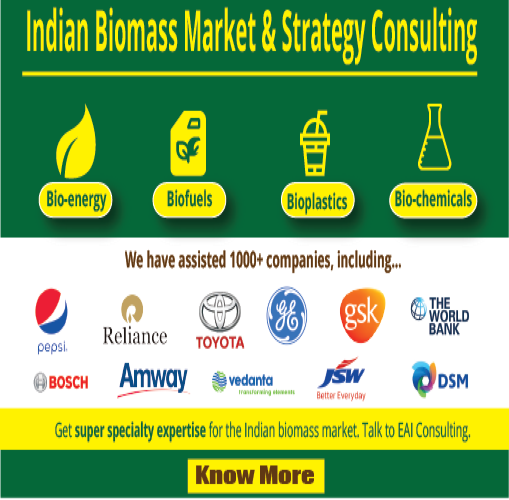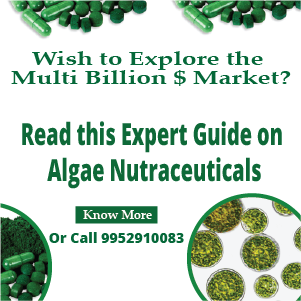Phycoerythrin
In addition to chlorophyll and the lipophilic pigments, such as the carotenoids, certain types of microalgae especially red algae, or rhodophyta, contain phycocyanin and Phycoerythrin (Becker 1994). These photosynthetic accessory pigments, collectively known Phycobiliproteins, are deeply coloured (red or blue), water soluble, complex, proteinaceous compounds. These algae pigments have the potential as natural colourants for food, cosmetics and pharmaceuticals.
R-Phycoerythrin (RPE) was originally isolated from red algae and has not been found in other taxa. Phycoerythrin is a major light-harvesting pigment of red algae and cyanobacteria that is widely used as a
fluorescent probe and analytical reagent. Visually, the phycoerythrins appear red, the phycocyanins range from purple (phycoerythrocyanin, R-phycocyanin) to deep blue (C-phycocyanin), and the allophycocyanins are blue with a hint of green.
The phycobiliproteins are proteins with linear tetrapyrrole prosthetic groups (bilins) that, in their functional state, are covalently linked to specific cysteine residues of the proteins.
Algae Strains that produce Phycoerythrin
Cyanobacteria, cryptomonads and Red algae like Porphyridium cruentum
Growth Conditions of Porphyridium cruentum
| Porphyridium cruentum | Cryptomonads |
Temperature | 20 ° C | 18° C |
pH | 7.6 | 7.8 |
Habitat | Sea water | Salt water |
Production Process
Pure phycobiliproteins from crude algal extracts are usually obtained by a combination of different and non-scaleable methods. Particularly, phycoerythrin is classically purified by a combination of several techniques such as ammonium sulphate precipitation, ion-exchange chromatography, gel filtration and chromatography on hydroxylapatite.
Purification procedures are often long and complex. For this reason the use of this biliprotein has been somewhat limited by the tedious preparation of adequate amounts of the purified protein.
Applications and Health Benefits of Phycoerythrin
- immunomodulating activity
- anticancer activity
- development of phycofluor probes for immunodiagnostics
Uses:
Phycobiliproteins are used as colorants in food (chewing gums, dairy products, ice sherbaths, gellies, etc.) and cosmetics such as lipstick and eyeliners in Japan, Thailand and China.
Dainippon Ink and Chemicals produces a blue food colourant from Spirulina, called Lina blue, that is used in chewing gum, ice slush, sweets, soft drinks, dairy products and wasabi.
Market
Heavy isotope labeled metabolites and Phycoerythrin (from Red algae and cyanobacteria) used as fluorescent labels could have values far exceeding $10,000 per kg.
Phycobiliproteins can be commercially produced from Spirulina and the red microalgae Porphyridium and Rhodella (Becker 1994; Singh et al. 2005; Borowitzka 2006; Spolaore et al. 2006). Phycobiliproteins are widely used in clinical or research immunology because they are very powerful and highly sensitive fluorescent properties (ProZyme 1999; Spolaore et al. 2006; Raja et al. 2008). In 1997 the global market for Phycobiliproteins colourants was estimated at US$ 50 million and prices vary from US$ 3 to US$ 25/mg (Spolaore et al. 2006).
Commercialization Status
Prominent Players in the Phycoerythrin Market
- Europa-bioproducts, Cambridge, UK
- Invitrogen, NY, USA
Research papers
1. Extracting and purifying R-phycoerythrin from Mediterranean red algae Corallina elongata Ellis & Solander
R Rossano, N Ungaro, A D'Ambrosio, G.M Liuzzi, P Riccio
Journal of Biotechnology, Volume 101, Issue 3, 20 March 2003, Pages 289-293
R-Phycoerythrin (R-PE) is a protein acting as a photosynthetic accessory pigment in red algae (Rodophyta). This protein has gained importance in many biotechnological applications in food science, immunodiagnostic, therapy, cosmetics, protein and cell labeling, and analytical processes. In this paper we report on a new, one step procedure for the extraction and purification of R-PE from a new source: the Mediterranean red algae Corallina elongata Ellis & Solander. This red algae contains mainly R-PE and is suitable for the production in culture. No other contaminating phycobiliproteins could be detected in the extracts. The method we propose for the purification is based on the use of hydroxyapatite, a chromatographic resin that can be produced in the laboratory at very low cost and can be used batch-wise with large amounts of extracts, alternative to chromatography, and therefore can be scaled up. Both the yield and the purity of R-PE are very good.
http://www.sciencedirect.com/science/article/pii/S0168165603000026
2. Recovery of pure B-phycoerythrin from the microalga Porphyridium cruentum
R. Bermejo Román, J.M. Alvárez-Pez, F.G. Acién Fernández,E. Molina Grima
Journal of Biotechnology Volume 93 (2002) Pages 73–85
Phycoerythrin is a major light-harvesting pigment of red algae and cyanobacteria that is widely used as a fluorescent probe and analytical reagent. In this paper, B-phycoerythrin and R-phycocyanin in native state, from the red alga Porphyridium cruentum were obtained by an inexpensive and simple process. The best results of this purification procedure were scaled up by a factor of 13 to a large preparative level using an anionic chromatographic column of DEAE cellulose. Gradient elution with acetic acid-sodium acetate buffer (pH 5.5) was used. In these conditions both 32% of B-phycoerythrin and 12% of R-phycocyanin contained in the biomass of the microalgae was recovered. B-phycoerythrin was homogeneous as determined by sodium dodecyl sulfate-poly-acrylamide gel electrophoresis (SDS-PAGE), yielding three migrating bands corresponding to its three subunits, consistent with the (αβ)6γ subunit composition characteristic of this biliprotein and the spectroscopic characterization of B-PE (UV–visible absorption and emission spectroscopy; steady-state and polarization fluorescence), is accompanied. Finally, a preliminary cost analysis of the recovery process is presented.
http://hera.ugr.es/doi/15086240.pdf
3. Characterization of the genes encoding phycoerythrin in the red alga Rhodella violacea: Evidence for a splitting of the rpeB gene by an intron
C. Bernard, J. C. Thomas, D. Mazeltt, A. Mousseau, A. M. Castetst, N. Tandeau De Marsact,And J. P. Dubacq
Proc. Nati. Acad. Sci. USA Vol. 89, pp. 9564-9568, October 1992
The phycobilisome of the eukaryotic unicellular red alga Rhodela violacea presents in some respects an organization that is intermediate between those of the homologous counterparts found in cyanobacteria (the putative chloroplast progenitor) and more advanced, pluricellular red algae. This suggests evolutionary relationships that we investigated at the genome level. The present work describes the sequences of two rhodophytan phycobilisome genes, rpeA and rpeB. These chloroplast genes encode the a and g3 subunits of phycoerythrin, the major component of the light-harvesting antennae and one of the most abundant cellular proteins in these algae. The amino acid sequences deduced from both ipeA and rpeB present strong homologies with those previously reported for phycoerythrin subunits of cyanobacteria, rhodophyta, and cryptomonads. The main difference with the corresponding cyanobacterial genes was the unexpected occurrence of an intervening sequence that split rpeB into two exons. This intervening sequence presents characteristics of group II introns but lacks several structural domains. Transcriptional analyses showed that the two Ipe genes are cotranscribed and that the major RNA species detected corresponds to a mature mRNA lacking the intron. As the phycobiliproteins form a group of closely related polypeptides in cyanobacteria and rhodophyta, the molecular events affecting the corresponding genes, such as the rpeB intron, may be a clue to elucidate some aspects of the molecular processes involved in the evolution of plastid genes.
http://www.pnas.org/content/89/20/9564.full.pdf
4. Biomass nutrient profiles of the microalga Porphyridium cruentum
M.M. Rebolloso Fuentes, G.G. Acién Fernández, J.A. Sánchez Pérez,J.L. Guil Guerrero
Food Chemistry 70 (2000) 345-353
Nutritional composition is analysed for the red microalga Porphyridium cruentum cultured under various conditions in an external tubular photobioreactor. The data include the proximate composition (moisture, ash, crude protein, available carbohydrates, fiber, lipids and energy), nitrate, RNA, mineral elements (Na, K, Ca, Mg, Fe, Cu, Zn, Mn, Cr, Mn, Co, S, As, Pb, Cd), C/N ratio, fatty acids and pigments (carotenoids, phycobiliproteins, chlorophylls and degradation products). On average, the biomass contains 32.1% (w/w) available carbohydrates and 34.1% crude protein. The mineral contents in 100 g dry biomass were: Ca (4960 mg), K (1190 mg), Na (1130 mg), Mg (629 mg) and Zn (373 mg). Toxic heavy metal contents were negligible. The fatty acid contents were (in percent dry wt): 1.6% of 16:0; 0.4% of 18:2o6; 1.3% of 20:4o6 and 1.3% of 20:5o3. Nutrient composition of biomass was highly influenced by residence time in the bioreactor and the external irradiance. The biomass collected for short residence times was richer in protein and eicosapentaenoic acid.
5. The Mass Culture of Porphyridium cruentum
Clarence G. Golueke and William J. Oswald
Appl Microbiol. 1962 March; 10(2): 102–107.
A study was made of the effect of temperature, detention period, light intensity, and salinity on the growth rate and over-all light energy conversion efficiency of Porphyridium cruentum cultured on a medium consisting of concentrated sea water and sewage enriched with urea, chelated iron, and other additives. It was found that the optimal temperature was within the range of 21 to 26 C. Growth was retarded at temperatures less than 13 C, and completely inhibited above 31 C. Over-all light energy conversion efficiency increased from 2.24% at the 4-day detention period to 2.76% at the 10-day period. Conversion efficiency ranged from 5.8% at a light energy absorption rate of 8.2 cal:liter:min to 2.3% at 35 to 39 cal:liter:min.
At salt concentrations less than 3.5%, Porphyridium could not successfully compete with other algae in open cultures. Salt concentrations as high as 4.6% had no inhibitory effect on its growth.
In studies on nutrition, it was found that growth on a medium of salts used in formulating synthetic sea water dissolved in sewage was equal to that on a control medium consisting of concentrated sea water and sewage (see above). They showed that sewage contains a substance or substances essential for optimal growth. Vitamin B12 alone could not substitute for it.
http://www.ncbi.nlm.nih.gov/pmc/articles/PMC1057821/pdf/applmicro00340-0012.pdf
Related Links
|
Click Here to Know More |
|
|
Poly unsaturated fatty acids(DHA,ARA,GAL and EPA) Aquaculture Feed (Shrimp feed, Shellfish Feed, Marine Fish Larve cultivation ) |
|



